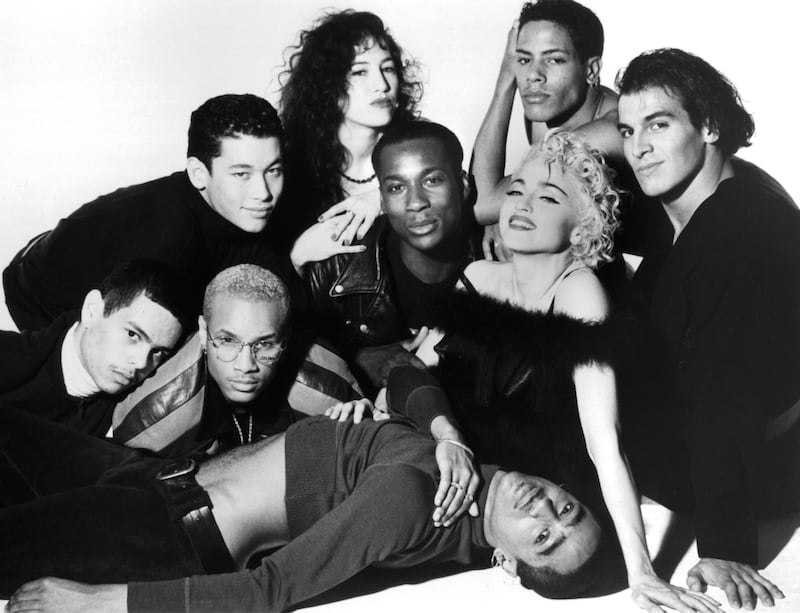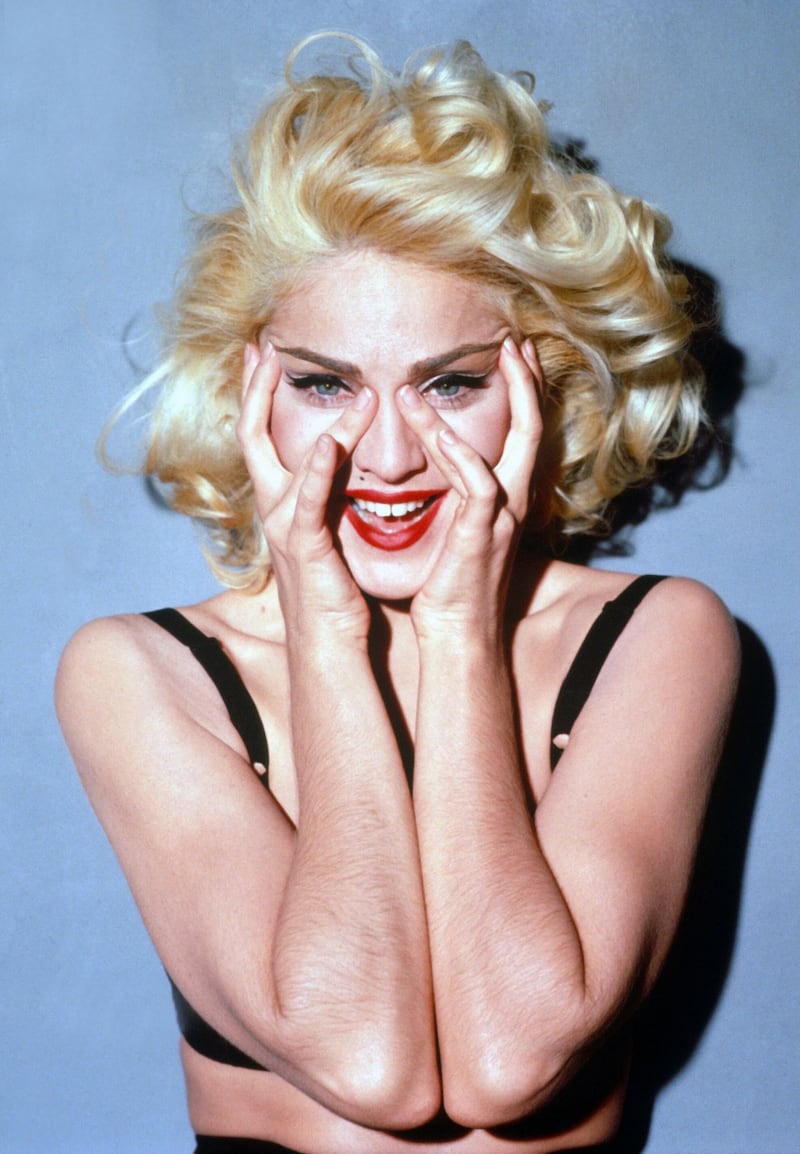When the teenage pop phenomenon Billie Eilish recently unveiled a drastic new image on the cover of Vogue magazine, the internet went into feverish overdrive. Previously distinguished by raven-dark locks and loosely androgynous, body-concealing attire, the singer instead turned to hyperfeminised exaggeration: bombshell-style platinum curls atop a tightly cinched, rose-coloured bustier, with a polite nod to fetishwear in its visible buckles and accompanying nude PVC skirt.
As showbiz makeovers go, it was unexpected, though not without precedent: older onlookers were quick to note that the 19-year-old had effectively “done a Madonna”, not only borrowing the chameleonic instincts of her 62-year-old elder but also plainly riffing on the OG Queen of Pop’s most defining look: the wildly stylised pin-up aesthetic of her 1990 Blonde Ambition tour, with its corsetry, conical bras and underwear-as-outerwear cheek.
The stars’ motivations may have differed slightly – in line with her new single Your Power, Eilish’s get-up accompanied an interview meditating on body positivity, consent and abuse, while Madonna’s was dedicated to expanding sexual boundaries – yet in 30 years, it seems, the pop impact of a well-chosen corset hasn’t dimmed.
In Bed with Madonna was no well-behaved personality profile. The objective was to present her highness as rude, raucous and hard to pin down – real, perhaps, but nothing like us
More coincidentally, Eilish’s Madonna homage arrives just as the older star’s most significant contribution to cinema celebrates its 30th anniversary. It’s three decades since In Bed with Madonna – aka Madonna: Truth or Dare – hit screens with a raucous bang, outperforming expectations with a $29 million gross that landed it the record, held for 11 years, of the highest-earning documentary of all time.
In doing so, it altered the popular perception of what the concert movie was supposed to be, turning the usual priorities of the filmed stage performance record inside-out, or backstage-forward: In Bed with Madonna was a hit not because it replicated the Blonde Ambition experience for those who couldn’t be there but because it invited fans into the altogether more unruly performance of the star’s real life.
None of this may sound especially revolutionary to a generation raised on 21st-century reality television, or indeed Instagram, where forging a candid sense of private life – off-camera but very much on camera – is now a standard clause of the celebrity contract. In 1991, however, stars of the magnitude of Madonna were prized for their distant mystique, not their familiarity.
In Bed with Madonna’s glimpses of the star at rest, kicking back with her entourage, her family and even her temporary squeeze Warren Beatty, felt genuinely revealing, even subversive. This was no well-behaved personality profile. The objective, stage-managed or otherwise, was to present her highness as rude, raucous and hard to pin down – real, perhaps, but nothing like us.
The director was fascinated by the freewheeling circus of Madonna's backstage life, surrounded by her self-described family of assistants, adjuncts and predominantly queer back-up dancers, with their own spiralling dramas and conflicts
That wasn't always the plan. In Bed with Madonna was initially conceived, more simply, as a straight-up concert doc, capturing what was already pretty cinematic about the Blonde Ambition tour's raunchy, elaborately choreographed theatre of sexual revolution. David Fincher, who had made his name with stylish music videos for the star's singles Vogue and Express Yourself, was lined up to direct; the film would effectively be a live, feature-length version of that same flash.
When Fincher pulled out, however, a young, Harvard-schooled music-video director named Alek Keshishian entered with different ideas. He was less fascinated by Madonna’s admittedly impressive onstage show than by the freewheeling circus of her backstage life, surrounded by her self-described “family” of assistants, adjuncts and predominantly queer back-up dancers, with their own spiralling dramas and conflicts.
Keshishian likened the crew to the bawdy ensemble of a Federico Fellini film; In Bed with Madonna, in turn, fashioned itself as the La Dolce Vita of rockumentaries, chaotically freeform and in thrall to sensuality and decadence, and shot largely in limber, grainy black-and-white for maximum verite cred.
By rights, it should have been an unendurable indulgence: it’s certainly an enthralled paean to a force-of-nature celebrity who already didn’t want for attention. Yet In Bed with Madonna was, and remains, riveting, as a study in community as well as a solo portrait.
Keshishian’s film is perhaps still undervalued as a queer-cinema milestone, normalising as it does the out-and-proud gayness of most of her dancers, without fetishising or exoticising their sexuality – relative, at least, to the blazing sexual energy of their glittery leader.

In Bed with Madonna was rare at the time in its everyday depiction of queer performers at work and at play, hanging out, gossiping or mingling around a New York Pride parade: Madonna is the freak of nature in their midst, not the other way around.
And, yes, for Madonna cultists it's an exhilarating snapshot of the star in her godly, don't-give-a-f**k prime, well before Kabbalah and Guy Ritchie and that cut-glass Ameringlish accent ate away at her cool. Contrastingly shot in bright, varnished colour, the film's concert sequences may be its least interesting material almost by design, yet they capture the brazen, cocksure performance presence that – well ahead of her vocal chops, as she herself admits – made her a phenomenon to begin with.
Backstage, the magnetism is undimmed. Thirty years on, the surprise of In Bed with Madonna is just what a blast the star is: nastily funny, openly horny, undisguised in her contempt for anyone she deems less fabulous than herself and her blessed collaborators. A postconcert encounter with an out-of-his-element Kevin Costner culminates in her gagging behind his back after he describes her show as "neat"; elsewhere, she announces her raging crush on the then-rising star (and her future Evita leading man) Antonio Banderas, and her blatant rage at his being married.
Such disarmingly awkward, off-the-cuff moments would never make the cut today, and if they did, the unholy alliance of Twitter and TMZ would scrutinise, analyse and meme all the fun right out of them: In Bed with Madonna captures celebrity culture in a tender transitional era between ironised self-awareness and exhaustive, personality-sapping PR training.

As such, the film blazed a trail for a genre of behind-the-music documentary that has rarely replicated Truth or Dare's genuine backstage-pass fizz and freedom. Fan-service films like Katy Perry: Part of Me or Justin Bieber: Never Say Never offer their viewers guarded, artificial access, carefully managing their subjects' private personae, and never risking the level of offence and outrageousness that Madonna blithely builds into her act here.
Is it the “real” Madonna performing fellatio on a water bottle, or sprawling dramatically on her mother’s grave, or is this another version of herself she’s devised for Keshishian’s camera? Madonna’s whole deal in the Blonde Ambition era was that it didn’t much matter: the real Madonna was the constructed one, and vice versa.
It's a far cry from the present day, when celebrities are expected to project a less mannered, less arrogant, altogether less fabulous authenticity to their admirers. Which brings us back to Billie Eilish, recently the subject of an altogether different documentary portrait: the renowned documentarian RJ Cutler's solemn, tasteful and rather affecting Billie Eilish: The World's a Little Blurry, which focuses intimately on the star's stern, introverted songwriting process, between more confessional interludes in which she reflects thoughtfully on her fears, insecurities and mental health.
In its own way, it’s as devoted and ambiguous a feat of pop portraiture as In Bed with Madonna, inviting similar questions about what is real and what is presented as such by its enigmatic star – yet what it’s selling is vulnerability, not fiery, untouchable, self-adoring confidence, which tells you much about how the ideal relationship between celebrity and fan has shifted in the past 30 years. Still, Eilish and her peers have many eras, and makeovers, ahead of her: perhaps Generation Z’s In Bed with Madonna still awaits us. – Guardian






















